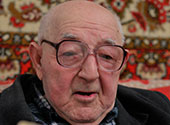
Yosl Kogan was born in 1927 in Bershad. His father, a soap-maker, died during the 1933 famine. He was brought up by his mother, a candy-maker. He spent much of the war in the Bershad ghetto, where he wrote songs about his experiences. He served in the Red Army and participated in the liberation of Berlin. After his military service, he worked at a liquor factory in Bershad, draining molasses. He moved to Tulchyn in 1960 and worked in a procurement office.
Other Interviews:
"I love Yiddish""And every day we waited to die"
Tsezeyt un tseshpreyt (Scattered and dispersed)
Inside the Ghetto
Aheym, briderlekh, aheym (Homeward, brother, homeward)
From the Chimney to Berlin
Valik, Zhuzhia and Ivanov
Tulchyn, Ukraine
Although they were designed with the goal of better integrating Jews into the Soviet system, Yiddish-language schools often had the opposite effect. By removing one of the most important venues of interethnic and intercultural exchange the modern state offered—integrated public schools—Yiddish-language schooling heightened the ethnic divisions between Jews and Ukrainians. Those who attended Yiddish schools were surrounded almost exclusively by other Jews and had their Jewish identity reinforced despite the curricular efforts to erase parochial ethnic identities. Many Jewish children socialized only with other Jews. But there were many who managed to traverse these ethnic boundaries. Sometimes, if they happened to live in Yiddish-speaking neighborhoods, non-Jews also enrolled in Yiddish-language schools. In this clip, Yosl Kogan remembers that there were several non-Jewish children who attended his Yiddish school in Bershad. But non-Jews in the Yiddish schools were an anomaly, and probably come up so often in our interviews precisely because they stood out so much. Jewish children in Ukrainian schools, though, were much more common than the other way around. The majority of Jewish schoolchildren in Ukraine were always enrolled in Ukrainian- or Russian-language schools; Yiddish-language schools never managed to attract even half of the Jewish schoolchildren. Source: Jeffrey Veidlinger, In the Shadow of the Shtetl: Small-Town Jewish Life in Soviet Ukraine (Indiana University Press, 2013)
